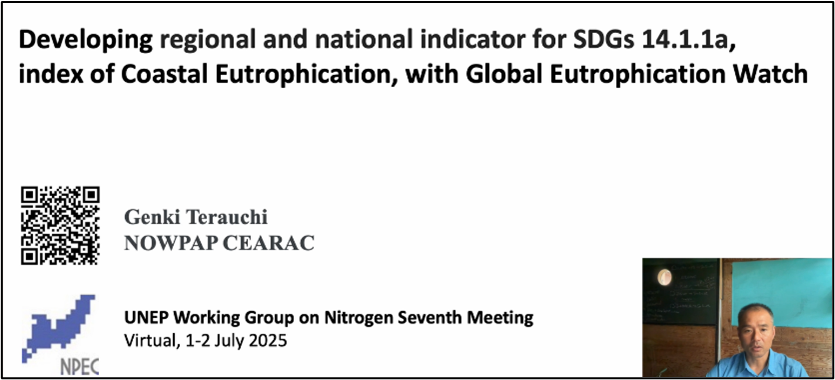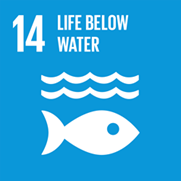At the 7th meeting of the UNEP Working Group on Nitrogen, held online on July 1-2, 2025, Dr. Genki Terauchi, a senior researcher at the Northwest Pacific Region Environmental Cooperation Center (NPEC), host organization of NOWPAP CEARAC, gave a video presentation on Global Eutrophication Watch (GEW). Considering that many countries are currently facing challenges in monitoring nutrients, including nitrogen, UNEP requested CEARAC to join the meeting and introduce a cloud-based application GEW developed by CEARAC as a model case. In the session on Agenda Item 6 “Monitoring of Nitrogen Pollution,” Dr. Terauchi delivered a lecture titled “Developing an updated version of the Global Eutrophication Watch and a prototype national reporting system for SDG indicator 14.1.1a” and demonstrated how to use GEW, a tool for assessing marine and coastal eutrophication caused by excessiv e nutrients on a global scale. He also introduced a project to develop a standardized national/regional level indicators of SDG 14.1.1(a): Index of Coastal Eutrophication, by using GEW.
e nutrients on a global scale. He also introduced a project to develop a standardized national/regional level indicators of SDG 14.1.1(a): Index of Coastal Eutrophication, by using GEW.
One of CEARAC’s mandates is to develop environmental monitoring and assessment tools by using remote sensing technology. As satellite data analysis is complex, CEARAC has long worked to make the data accessible to anyone without any specialized skills. Dr. Terauchi explained that measuring chlorophyll-a (CHL)concentration by satellite remote sensing makes it possible to map and assess the status of eutrophication globally.
GEW developed by CEARAC in 2021 efficiently processes satellite data based on CHL concentration trends and levels, and visualizes eutrophication potential on a map by using G oogle Earth Engine that analyzes large-scale environmental data. This tool enables quick identification of the eutrophication status of target sea areas, by classifying them as either ① healthy, ② recovering, or ③ high-risk/severely impacted. GEW requires only a few clicks to process accumulated data for more than 20 years to assess potential of eutrophication status in seconds.
oogle Earth Engine that analyzes large-scale environmental data. This tool enables quick identification of the eutrophication status of target sea areas, by classifying them as either ① healthy, ② recovering, or ③ high-risk/severely impacted. GEW requires only a few clicks to process accumulated data for more than 20 years to assess potential of eutrophication status in seconds.
Dr. Terauchi demonstrated the usability of GEW with examples from various regions, including the Ariake Sea, the Bohai Sea, and the Gulf of Thailand. The GEW map showed its high-quality performance in accurate assessment of eutrophication status in rather small bays with higher resolution data and in turbid coastal waters with specifically tuned data.
 At the end of the presentation, Dr. Terauchi mentioned a joint research project (2025-2027) led by him and funded by the Japan Aerospace Exploration Agency (JAXA). This project aims to develop SDG 14.1.1(a): Index of Coastal Eutrophication at national and regional levels based on GEW, using CHL data from the SGLI sensor on JAXA’s GCOM-C “Shikisai” satellite. As a result, Global Eutrophication Watch is expected to make a significant contribution to the United Nations’ SDG 14: Life below water.
At the end of the presentation, Dr. Terauchi mentioned a joint research project (2025-2027) led by him and funded by the Japan Aerospace Exploration Agency (JAXA). This project aims to develop SDG 14.1.1(a): Index of Coastal Eutrophication at national and regional levels based on GEW, using CHL data from the SGLI sensor on JAXA’s GCOM-C “Shikisai” satellite. As a result, Global Eutrophication Watch is expected to make a significant contribution to the United Nations’ SDG 14: Life below water.
The two-day meeting brought together 112 participants representing governmental agencies, international organizations, academia, NGOs, and children and youth groups, who engaged in many insightful discussions and meaningful exchanges.
Official website of the 7th meeting of the UNEP Working Group on Nitrogen:
https://www.unep.org/events/working-group-meeting/seventh-meeting-unep-working-group-nitrogen

